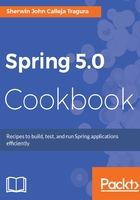
Conventions
In this book, you will find a number of text styles that distinguish between different kinds of information. Here are some examples of these styles and an explanation of their meaning.
All recipes codes are written inside a numbered bullet and follow the following style:
public Set<String> getDistinctNames(){
Function<Employee,String> allNames = (e) -> e.getFirstName();
Set<String> setNames = employeeDaoImpl.getEmployees()
.stream()
.filter((a) -> a.getAge() > 25)
.map(allNames)
.collect(Collectors.toCollection(HashSet::new));
return setNames;
}
Code words in text, HTML tags, database table names, folder names, filenames, file extensions, and pathnames are shown as follows: "Import socketapps.js inside hotline.html using the <script> tag"
A URL is written as follows: "Visit the site https://www.mongodb.com/download-center#community to download MongoDB under different operating system platforms. It also comes with SSL and no-SSL support."
Acronyms and module names may be shown in bold: "The Hibernate 5 has no dedicated starter POM in Spring Boot 2.0, but it is by default contained in the Spring Data JPA starter POM."
Any command-line input or output is written as follows:
keytool -import -alias spring5server -file spring5packt.crt -keystore "<Java1.8_folder>\Java1.8.112\jre\lib\security\cacerts" -storepass changeit
New terms and important words are shown in bold. Words that you see on the screen, for example, in menus or dialog boxes, appear in the text like this: "On the dashboard, look for IDE EXTENSIONS and click that button".
Important phrases, terminology, ideas, and concepts are written in this style: "MongoDB is an unstructured database so it has no concept of relational models such as database and table schema".